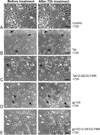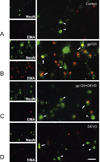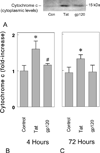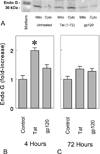Apoptotic death of striatal neurons induced by human immunodeficiency virus-1 Tat and gp120: Differential involvement of caspase-3 and endonuclease G
- PMID: 15204919
- PMCID: PMC4309288
- DOI: 10.1080/13550280490441103
Apoptotic death of striatal neurons induced by human immunodeficiency virus-1 Tat and gp120: Differential involvement of caspase-3 and endonuclease G
Abstract
Human immunodeficiency virus-1 (HIV-1) infection affects the striatum, resulting in gliosis and neuronal losses. To determine whether HIV-1 proteins induce striatal neurotoxicity through an apoptotic mechanism, mouse striatal neurons isolated on embryonic day 15 and the effects of HIV-1 Tat(1-72) and gp120 on survival were assessed in vitro. Mitochondrial release of cytochrome c, caspase-3 activation, and neuron survival, as well as an alternative apoptotic pathway involving endonuclease G (endo G), were assessed at 4 h, 24 h, 48 h, and/or 72 h using enzyme assays and immunoblotting. Both HIV-1 Tat and gp120 significantly increased caspase-3 activation in a concentration-dependent manner in striatal neurons at 4 h following continuous exposure in vitro. Tat(1-72) and gp120 caused significant neuronal losses at 48 h and/or 72 h. Tat(1-72) increased cytochrome c release, and caspase-3 and endo G activation at 4 h, 24 h, and/or 72 h. By contrast, gp120 increased caspase-3 activation, but failed to increase cytochrome c or endo G levels in the cytoplasm at 4 h, 24 h, and/or 72 h. The cell permeant caspase inhibitor Z-DEVD-FMK significantly attenuated gp120-induced, but not Tat(1-72)-induced, neuronal death, suggesting that gp120 acts in large part through the activation of caspase(s), whereas Tat(1-72)-induced neurotoxicity was accompanied by activating an alternative pathway involving endo G. Thus, although Tat(1-72) and gp120 induced significant neurotoxicity, the nature of the apoptotic events preceding death differed. Collectively, our findings suggest that HIV-1 proteins are intrinsically toxic to striatal neurons and the pathogenesis is mediated through separate actions involving both caspase-3 and endo G.
Figures







References
-
- Adamson DC, Wildemann B, Sasaki M, Glass JD, McArthur JC, Christov VI, Dawson TM, Dawson VL. Immunologic NO synthase: elevation in severe AIDS dementia and induction by HIV-1 gp41. Science. 1996;274:1917–1921. - PubMed
-
- Adle-Biassette H, Levy Y, Colombel M, Poron F, Natchev S, Keohane C, Gray F. Neuronal apoptosis in HIV infection in adults. Neuropathol Appl Neurobiol. 1995;21:218–227. - PubMed
-
- Albini A, Benelli R, Presta M, Rusnati M, Ziche M, Rubartelli A, Paglialunga G, Bussolino F, Noonan D. HIV-1 Tat protein is a heparin-binding angiogenic growth factor. Oncogene. 1996a;12:289–297. - PubMed
-
- Albini A, Soldi R, Giunciuglio D, Giraudo E, Benelli R, Primo L, Noonan D, Salio M, Famussi G, Rockl W, Bussolino F. The angiogenesis induced by HIV-1 Tat protein is mediated by the Flk-1/KDR receptor on vascular endothelial cells. NatMedl: 1996b:1371–1375. - PubMed
Publication types
MeSH terms
Substances
Grants and funding
LinkOut - more resources
Full Text Sources
Research Materials

